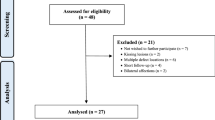Summary
A total of 11 patients suffering from osteochondrosis dissecans or posttraumatic osteochondral defects of the talus were treated by autologous chondrocyte transplantation (ACT) in a prospective study. Brittberg published in 1994 the first results of ACT. We have used this method since 1997. There were 11 patients with an average age of 30.1 years (22 to 42). Eight patients had a trauma of the ankle in their history; six patients had a previous surgery. The size of the lesion was 14×12 mm (mean). An additional osteotomy of the malleolus was necessary in 7 patients. Arthroscopic reexamination of three patients showed the existence of complete coverage of the chondral defect. The review protocol included clinical examination, X-ray, and magnetic resonace imaging (MRI). For comparative evaluation the Finsen score was used. According to the Finsen score, an improvernent from an average score of 3.1 points pre-op. to 1.2 points at the mean follow-up at 18.4 months was obtained. This method enables reconstructive intervention in a selected patient group for unicompartmental defects of articular cartilage through implantation of new chondrocytes, establishment of a subchondral blood supply, and reconstruction of the articular surface.
Zusammenfassung
Bei osteochondralen Läsionen am Talus stehen mehrere Behandlungsmöglichkeiten zur Verfügung und nach wie vor ist die geeignete chirurgische Therapieform umstritten. Die autologe Chondrozytentransplantation (ACT) wurde 1994 von Brittberg zur Behandlung von Knorpeldefekten des Kniegelenkes vorgestellt. Seit 1997 haben wir selbst Erfahrung mit der Anwendung der ACT. Im Rahmen einer prospektiven Studie wurden bei 11 Patienten (a Frauen und b Männer) mit einem Durchschnittsalter von 30,8 Jahren (22–42 Jahre) aufgrund einer chondralen Läsion eine ACT am Talus vorgenommen. Acht Patienten hatten eine Trauma des Sprunggelenkes in ihrer Anamnese. Sechs Patienten waren aufgrund der bestehenden osteochondralen bzw. chondralen Läsion bereits voroperiert. Die Defekte waren im medialen Talus (n–6), im lateralen Talus (n=3) und im zentralen Talusbereich (n=2) lokalisiert. Die durchschnittliche Defektgröße betrug 14×12 mm. Bei 7 Patienten wurde zusätzlich eine Malleolarosteotomie zur Darstellung des Operationssitus durchgeführt. Das mittlere Followup betrug 18,4 Monate (8–26 Monate). Bei drei Patienten konnte eine Kontrollarthroskopie durchgeftihrt werden. Zur Verlaufsbeurteilung erfolgte postoperativ eine klinische Untersuchung, konventionelle Röngtendiagnostik und MRI-Kontrollen. Der Finsen-Score aller Patienten verbesserte sich von präoperativ im Mittel 3,1 Punkte auf postoperativ im Mittel 1,2 Punkte. Obgleich zurzeit noch keine mittel- und langfristigen Ergebnisse vorliegen sehen wir bei strenger Indikationsstellung in ausgewählten Fällen die Indikation zu einer autologen Chondrozytentransplantation am Talus als gegeben.¶
Similar content being viewed by others
Author information
Authors and Affiliations
Additional information
Eingegangen: 21. November 2002/Akzeptiert: 27. November 2002
Correspondence to:Wolfgang Schultz
Rights and permissions
About this article
Cite this article
Schultz, W., Klinger, HM. & Koulalis, D. Die autologe Chondrozytentransplantation am oberen Sprunggelenk. FussSprung 1, 0008–0011 (2003). https://doi.org/10.1007/s10302-003-0017-9
Issue Date:
DOI: https://doi.org/10.1007/s10302-003-0017-9




